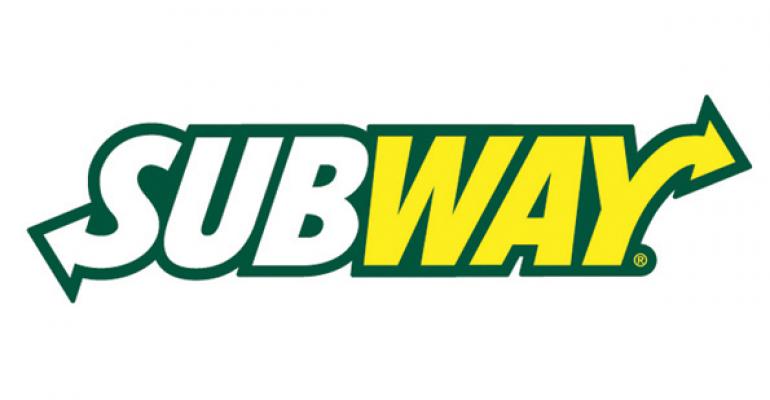Subway has had a challenging year.
The Milford, Conn.-based quick-service sandwich chain has seen sales stagnate, and has transitioned daily operations to Suzanne Greco while founder Fred DeLuca, Greco’s brother, fights leukemia.
The last thing Subway needed was video of FBI agents at the home of brand spokesman Jared Fogle during a surprise raid Tuesday morning. By the end of the day, Subway had suspended arguably its most important relationship over the past 15 years.
Subway finds itself at a crossroads. The chain that once considered growth to be part of its birthright this year saw Starbucks leapfrog it as the nation’s second-largest restaurant chain, according to the Nation’s Restaurant News Top 100 census.
Subway now has to find ways to get customers to return to its restaurants. And it must do so without the man given considerable credit for much of the chain’s success over the past 15 years.
“It’s a nightmare,” said John Gordon, a San Diego-based restaurant consultant. “Subway has invested so much time and attention, and he became such a story. And unlike most restaurant brands, they stuck with the Jared story for years and years and years. And he had a considerable lifespan to go. It takes that potential marketing tool away from them going forward.”
DeLuca co-founded Subway in 1965 with family friend Dr. Peter Buck in Bridgeport, Conn. The chain began franchising in 1974, and it soon took off. It was well established by 1999, when Men’s Health magazine profiled an Indiana man named Jared Fogle who lost 245 pounds by eating Subway sandwiches.
The next year, Fogle began appearing in ads for Subway. He would soon become the face of the brand — an image of a regular man who struggled with his weight and then succeeded in losing much of it, simply by eating its food.
The ad was a milestone, giving Subway a perception of healthfulness unlike any other quick-service chain, and lifting its consumer perception. A 2013 study by the consulting firm Technomic gave Subway the highest scores for consumer perceptions among restaurant brands. That was due in part to advertising that consumers found relatable.
That perception remains. Mary Chapman, senior director of product innovation at Technomic, said Subway is at the top of the list of restaurant chains for consumers’ views of their healthful options. That is significant at a time when consumers repeatedly indicate they want to eat healthfully.
The consumer perception of Subway helped lift sales. In 1998, Subway had domestic system sales of $3.1 billion. By 2012, its system sales exceeded $12 billion, according to NRN data.
But the chain’s relationship with Fogle came crashing down Tuesday morning with the home raid. The raid came just months after Russell Taylor, executive director at his nonprofit childhood obesity foundation, The Jared Foundation, was arrested on child pornography charges. Reports Tuesday suggested the raid was over a child pornography investigation, but it was unclear who was the target of the inquiry.
On Wednesday, Subway operators could be seen removing Fogle’s likeness from their restaurants.
The end of the relationship came just weeks after Subway named Suzanne Greco president. Greco, who has been involved with the company since the beginning and had held many roles at the chain, now oversees daily operations while DeLuca focuses on his health. DeLuca retains the CEO title.
Meanwhile, Subway’s sales have been stagnant. Sales per unit, as estimated by NRN, have fallen in each of the past two years, and systemwide sales have been flat each of those years. Exactly why sales started to suffer two years ago is somewhat of a mystery.
“It doesn’t seem that they’ve discovered what’s wrong with the business and why business momentum has shifted,” Gordon said.
One potential culprit: Subway ended its successful $5 Footlong promotion. Chains often have a difficult time after eliminating value promotions. Subway’s was so popular that some say it accelerated the demise of competitor Quiznos.
More competition, sandwich chains
The market is also much more competitive. For years, Subway had been the place for consumers to go when they wanted a freshly prepared meal made right in front of them.
In recent years, fast-casual chains like Chipotle Mexican Grill and others have adopted the assembly line process as their own, giving consumers more options.
“There’s just more competition in both the healthy quick items and the customizable quick items,” Chapman said. “For a long time, Subway was the only place you could go and get your meal made how you want. Now there’s a lot of places you can go and get that done.”
There are also more sandwich chains these days, including Jimmy John’s, Firehouse Subs and Jersey Mike’s, all of which are growing quickly. For instance, Jimmy John’s systemwide sales grew nearly 20 percent last year, according to NRN data.
“Firehouse Subs, Jimmy John’s and other chains are expanding pretty quickly,” said Dennis Lombardi, executive vice president at WD Partners. “They’re putting some competitive pressure on them.”
To be sure, Subway still has a lot of clout. The brand remains the single largest restaurant chain in the world in terms of unit count. It has a massive marketing budget and a legion of celebrities among its “Famous Fans,” like basketball player Russell Westbrook and Major League Baseball player Mike Trout.
All brands, at one time or another, go through downturns.
“It’s still an incredible brand with a lot of consumer perceptions and viability,” Lombardi said. “They’ve done a lot of things right over the last six, seven or eight years.”
“Brands live through changes in ownership and changes in senior management,” Lombardi added. “Sometimes the stars line up against you and it feels like a lot of things are happening at the same time. But when you’re a brand of that size, that has established itself in the market, you’ll figure it out. The brand will probably figure its way out of it.”
Contact Jonathan Maze at [email protected].
Follow him on Twitter: @jonathanmaze





